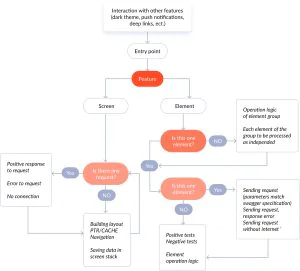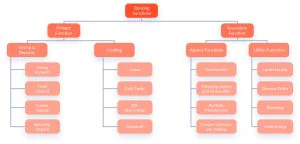As you wake up one morning from uneasy dreams, you find your banking app transformed into a gigantic “bug”. Nobody understands anything: transactions are blocked, half of the data disappeared, and new users can’t create an account.
It all sounds like Franz Kafka’s The Metamorphosis. The main character transformed into a huge insect all of a sudden, and his family didn’t know how to handle this absurd situation. But our example hints us why banking app testing is that important. Users are particularly fussy about fintech products because their money and private data are at stake, so nobody wants to risk losing both of them. Your customers don’t have to accept your buggy banking app as it is, because they can go find a working one.
While anybody can turn into a large bug, according to Franz Kafka, you can’t let the same happen to your banking app. For that reason, the JatApp’s Quality Assurance (QA) team presents you an exclusive guide on how to test banking applications. Our QA Team Lead has his own opinion: if you see a bug in a banking app, you should fix it (because it’s not your relative)!
Reasons to be careful with banking app quality assurance
You won’t argue that quality assurance and testing of any software is crucial, but what’s so special about banking apps and their testing process? As any banking app works with large amounts of data and people’s money, it includes components that make the app insanely complicated:
- Multi-tier functionality to support thousands of concurrent user sessions. A banking app usually includes several independent tiers such as database, payment processor, user interface, and app’s logic server. All these parts should work together as one solid unit, while getting all pieces together is a challenging task that isn’t always handled well.
- Third party integrations at a large scale. A rare banking app isn’t connected to any third party service via application programming interfaces (APIs). Linking the app through APIs to external services is one of the main perks of any banking app. Neobanks can connect to multiple APIs, so it’s natural that errors happen.
- Complex business workflows. We lack words to describe how banking business workflows are brutal in their complexity. So, take a deep breath, look at the scheme below, and then drink a glass of water.
- Real-time and data processing. A banking app processes thousands of transactions all the time. Imagine that data going back and forth, heavily jammed with traffic. It’s obvious that a crash will happen sooner or later.
- Overly sophisticated security. Having poor security in your banking app is an utter sign of disrespect to your customers who put trust in your solution. You always have to be concerned about security measures in the app, but making them sophisticated increases the probability of errors.
- Robust reporting and audit system. Keeping an eye on all transactions as well as customer issues is a hard process, which is why you can expect bugs and errors within this component of your banking app.
- Massive storage system. We’ve mentioned that a banking app contains tons of data. That is why data storage is large enough to create a room for inevitable errors. In the same vein, data recovery management is another hefty task to handle, as relatable processes can create loopholes through which bugs run uncaught.
Steps to repel bugs from your banking app
Since banking apps are a special fintech breed, its testing process is different from QA of other applications. However, basic rules of software testing are still applicable. You can learn more about them in our dedicated article, while here we are focusing on testing stages relevant solely to banking apps:
- Requirements analysis. During this primary stage, your QA team should work closely with a project manager and business analyst to review technical specifications of your banking app and determine critical aspects to pay attention to.
- Requirements review. At this stage, the QA team, along with other tech specialists, have to double check whether technical requirements are documented properly, and there is no violation of the app’s logic or its core components. By doing so, your QA team can prevent serious errors that will block timely and budget-friendly delivery of your banking app.
- Business requirements documentation. This stage is similar to requirements analysis and review, but your QA engineers work with the business aspect of your banking app. Your QA team needs to analyze business scenarios, separate use cases, and even narrow-specific test cases to determine low-level problems that may arise. We highly recommend involving an expert with banking domain knowledge at this stage to ensure that banking domain testing is relevant to business requirements of your app. In such a way, you’ll save time on testing and make your banking app truly serve its purpose.
- Functional testing. This is a standard testing stage, when QA engineers apply different test cases to your banking app functionality. At this point, the aim of your QA team is to determine whether all app’s features work properly.
- Database testing. Once your banking app has a gigantic database, it requires separate testing. Usually, QA engineers run tests to check data loading, database schemas and data types, data rules, data integrity, and database storage capacity. Additionally, your QA team has to run structural tests to reveal any problems in database architecture and database functional testing to see whether the database meets the technical/business requirements.
- Security testing. It is the most important part of software testing for banking so far. Your QA team must make sure that there are no loopholes and vulnerabilities in your security system, thereby enabling users to enjoy your app without being worried about their money and private data. To test the security of a banking app, QA engineers run such tests as vulnerability testing, security scanning, penetration testing, security audit, risk assessment, ethical hacking, posture assessment, and SQL injection test.
- Integration testing. As long as a banking app connects to external services via APIs, your QA team has to test them as well to be sure that all third-party integrations work well.
- Usability testing. This testing phase relates to checking how well user interface/user experience (UI/UX) designs are doing their job. Banking apps involve complex features and customers may face difficulties with understanding how to use them properly. In addition, let’s not forget that your app deals with the money of your customers, which means that every single user flow should be as user-friendly as possible. For that reason, efficiency of UI/UX design requires thorough testing.
- User acceptance testing. Last but not least, this testing stage is actually the job to be done by your users. When you release your banking app, it will undergo testing in real-world business scenarios, and your customers will leave feedback about the performance of your app. Your QA team needs to analyze this feedback and propose improvements not only for usability of your app, but also its technical performance. The app will face real data loads with the increase at peak business hours and seasonal events like monthly salary payouts, Christmas sales, and such.
Tests types and examples
Banking application testing includes unique test cases that your QA team should be able to write, run, and automate:
- Admin panel testing. Test cases typical of this banking app component include verification of administrator login and logout processes, change of authorization credentials, and checking all admin panel home links.
- New branch. We can single out three subtypes of test cases here. The first one relates to creation of a new branch with valid/invalid/no data, and creating a new branch with data from an existing branch. The second group of test cases aims at verification of reset and cancel options, branch deletion with and without dependencies, and branch search. The third subtype is checking the update of valid and invalid data, branch update without data, update with existing branch data, and log in with existing branch test data.
- New role. These test cases pursue checking whether a new role can be created and updated over time within your banking app. For example, it’s critical to understand whether a recently connected business has all functionality available or whether a particular external service works properly.
- Users. First of all, testing Know-Your-Customer service (KYC) is necessary because it’s responsible for user authentication and updates of user credentials. Besides, checking the process of creating or adding a new user with its further attachment to a bank account is paramount. We need to highlight that these tests are oriented at your app’s logic rather than user interface.
Magic tools to turn bugs into a working code
Software testing for banking requires a lot of tools to make your product really bugless. The following list includes the most important instruments for testing your app, but we should mention that it’s not exhaustive. Your QA team may add any extra tools to preserve your product from bugs and errors. The tools list is the following:
- Dart + Gherkin. This tool enables your QA engineers to run automated tests for Flutter-written applications.
- RubyMine. Mobile banking app testing requires its own automated test cases. You can automate the majority of tests with this tool used for apps written with a cross-platform programming language.
- Charles. Once a lot of data is involved, tracking traffic flow between the Internet and virtual machine is essential. The tool creates HTTP proxy to view HTTP and SSL traffic.
- Android Debug Bridge. It is a debugging tool for the Android version of your banking application.
- Xcode. If you have an iOS native banking app, this tool will help your testing team to create a robust test environment.
- Android Studio. Your QA team can use this tool to edit code in the Android version of your banking app.
- Jenkins. Comes in handy when you’re approaching your app development according to continuous integration/continuous development (CI/CD) principles. Jenkins is a tool which will ensure that QA and testing fit into your CI/CD pipeline.
- Mocker. In case your front end development process goes faster than the back end development, but you need to test some components, Mocker will help your QA team emulate back end responses.
- Selenium. To automate tests of your app’s web version, your QA engineers just need to use this tool.
- Apache Poi Library. When a bug is detected, it requires fixing. With this pure Java library, your QA team will handle any bug fixing with a little hassle.
- Postman. APIs are an essential part of any banking app, and you need a tool that can help your QA engineers to test relatable APIs of your product. This is what Postman is all about.
Best practices you shouldn’t avoid
Apart from the essentials of banking app testing, the JatApp QA team has several testing best practices, which we would like to share with you:
- Test data complexity improvement. Banking app data, as well as relationships between data sets, are always complicated. For that reason, we highly recommend a continuous work on elaboration of data sets for testing. As a result, your QA team will be able to write test cases for the most complex data, thereby detecting the fattest bugs.
- Combination of APIs in user interface functionality tests. We’ve mentioned the need for testing APIs a couple of times, but we also want to highlight that third-party service APIs should be tested in isolation from the user interface of your banking app. It’s good to see whether a particular API is working, but you’re interested in the end result for your users, which means you need to see whether external services interact with the UI well enough.
- Testing specific banking scenarios. We encourage you to invest enough resources in writing unique banking-related test cases based on real-world business scenarios. Again, a banking app differs from other digital products, which is why testing all unexplored areas is critical. You can’t know for sure how this or that process will affect your app’s logic or functionality.
Challenging doesn’t mean impossible
The Metamorphosis ends on a tragic note, as the main character turned into a big bug dies, abandoned by his family. But there is no room for drama in fintech, and that’s what JatApp strongly believes in.
If you need to test your banking app or build one from scratch, you can always count on us. JatApp has been developing fintech products since 2015, so we have a team of professional QA engineers who will keep an eye on even the canniest bugs attempting to spoil the success of your banking app.
Want to learn more about how we work? Just contact us. We will get back to you as soon as possible.











